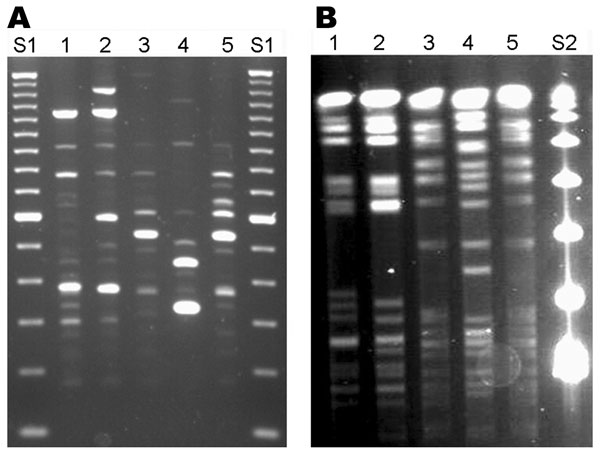Volume 13, Number 8—August 2007
Letter
Mycobacterium cosmeticum, Ohio and Venezuela
Figure

Figure. Repetitive element (Rep)–PCR (A) and pulsed-field gel electrophoresis (PFGE) (B) patterns of Mycobacterium cosmeticum isolates from 2 patients in Ohio and 1 patient in Venezuela. Rep-PCR was performed by using BOXA1R primer (3), and PFGE was performed with restriction enzyme AseI. Lanes 1, 2, Ohio isolates OH1 and OH2; lanes 3, 4, control strains ATCC BAA-878T and ATCC BAA-879; lane 5, Venezuelan isolate VZ1. DNA size standards are 100-bp (S1) and 48.5-kb marker (S2).
References
- Cooksey RC, de Waard JH, Yakrus MA, Rivera I, Chopite M, Toney SR, Mycobacterium cosmeticum sp. nov., a novel rapidly growing species isolated from a cosmetic infection and from a nail salon. Int J Syst Evol Microbiol. 2004;54:2385–91. DOIPubMedGoogle Scholar
- Pfyffer GE, Brown-Elliott BA, Wallace RJ Jr. Mycobacterium: general characteristics, isolation, and staining procedures. In: Murray PR, Baron EJ, Pfaller MA, Jorgensen JH, Yolken RH, editors. Manual of clinical microbiology. Washington: ASM Press; 2003. p. 532–59.
- Dombek PE, Johnson LK, Zimmerley ST, Sadowsky MJ. Use of repetitive DNA sequences and the PCR to differentiate Escherichia coli isolates from human and animal sources. Appl Environ Microbiol. 2000;66:2572–7. DOIPubMedGoogle Scholar
- Wagner D, Young LS. Nontuberculous mycobacterial infections: a clinical review. Infection. 2004;32:257–70. DOIPubMedGoogle Scholar
Page created: June 30, 2010
Page updated: June 30, 2010
Page reviewed: June 30, 2010
The conclusions, findings, and opinions expressed by authors contributing to this journal do not necessarily reflect the official position of the U.S. Department of Health and Human Services, the Public Health Service, the Centers for Disease Control and Prevention, or the authors' affiliated institutions. Use of trade names is for identification only and does not imply endorsement by any of the groups named above.